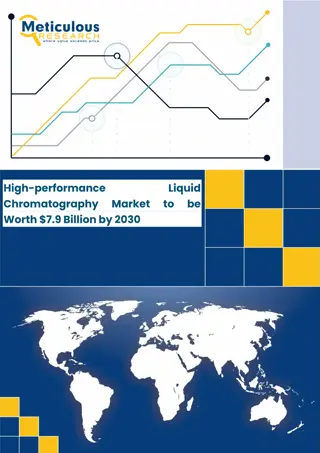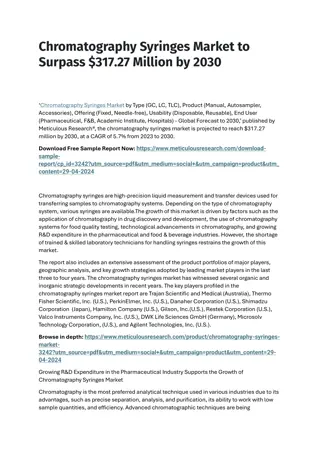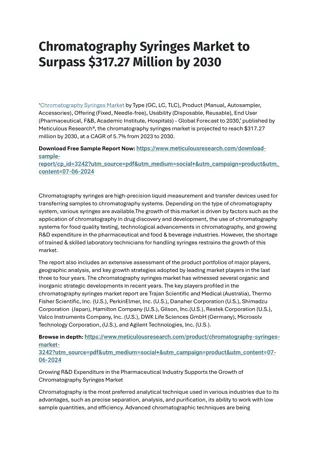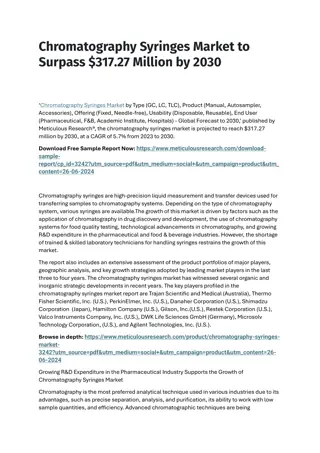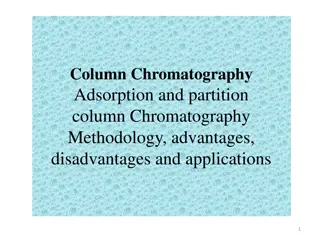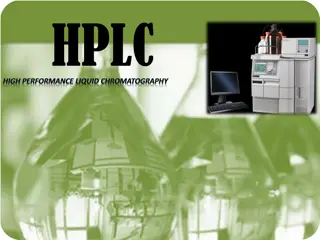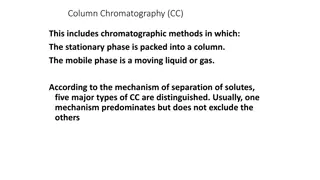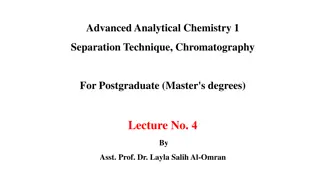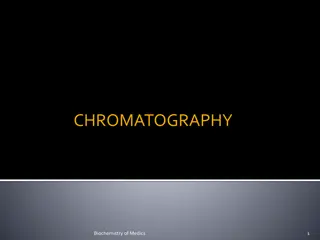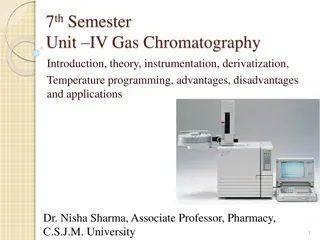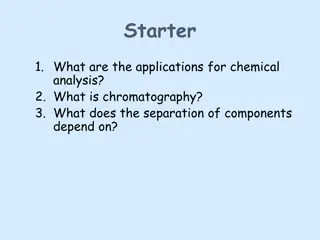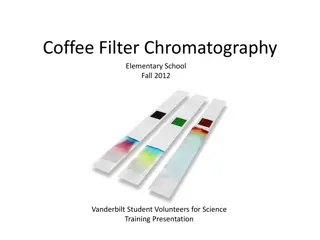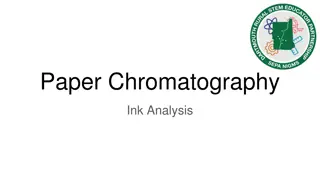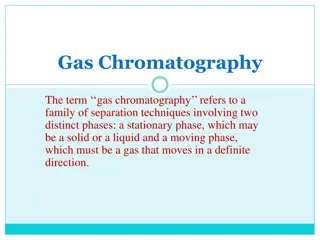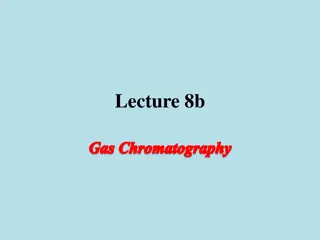Understanding High Performance Liquid Chromatography (HPLC)
High Performance Liquid Chromatography (HPLC) is a powerful analytical technique used to separate, identify, and quantify components dissolved in a liquid solvent with high resolution. It involves pumping the sample mixture through a column at high pressure, where the components interact with the stationary and mobile phases to enable separation based on retention time. HPLC is widely used in various industries for applications such as pharmaceuticals, environmental analysis, forensics, and more.
Download Presentation

Please find below an Image/Link to download the presentation.
The content on the website is provided AS IS for your information and personal use only. It may not be sold, licensed, or shared on other websites without obtaining consent from the author. Download presentation by click this link. If you encounter any issues during the download, it is possible that the publisher has removed the file from their server.
E N D
Presentation Transcript
High performance liquid chromatography (HPLC) Separate, identify & quantify components dissolved in a liquid solvent with a high analytical resolution. Sample carried by a moving gas stream of Helium or Nitrogen
High Performance Liquid Chromatography (HPLC) is a form of column chromatography that pumps a sample mixture or analyte in a solvent (known as the mobile phase) at high pressure through a column with chromatographic packing material (stationary phase). The sample is carried by a moving carrier gas stream of helium or nitrogen. HPLC has the ability to separate, and identify compounds that are present in any sample that can be dissolved in a liquid in trace concentrations as low as parts per trillion. Because of this versatility, HPLC is used in a variety of industrial and scientific applications, such as pharmaceutical, environmental, forensics, and chemicals.
Retention Time: The retention time of a solute is taken as the elapsed time between the time of injection of a solute and the time of elution of the maximum peak of that solute. Sample retention time will vary depending on the interaction between the stationary phase, the molecules being analyzed, and the solvent, or solvents used. As the sample passes through the column it interacts between the two phases at different rate, primarily due to different polarities in the analytes. Analytes that have the least amount of interaction with the stationary phase or the most amount of interaction with the mobile phase will exit the column faster.
Response D B A C 15 25 10 20 5 Retention Time
Instrumentation: : Main components in an HPLC system include the solvent reservoir, or multiple reservoirs, a high-pressure pump, a column, injector system, the detector and waste.
The reservoir holds the solvent, which is referred to as the mobile phase because it moves. There are usually a minimum of two reservoirs in a system, with each holding up to 1000 cc of solvent and usually fitted with a gas diffuser through which helium can be bubbled. A pump is used to generate a specified flow of the mobile phase. Although manual injection of samples is still possible, most HPLCs are now fully automated and controlled by computer.
The injector, or auto sampler, introduces the solvent into a phase stream that carries the sample into the high pressure (up to 400 bar) column, which contains specific packing material needed to effect separation. The packing material is referred to as the stationary phase because it is held in place by the column hardware. A detector is needed to see the separated compound bands as they elute from the high pressure column. The information is sent from the detector to a computer which generates the chromatogram. The mobile phase exits the detector and is either sent to a waste, or collected, as desired.
Separation: Injector Chromatogram Mixer mAU Pumps time Start Injection Column Detector Solvents
Separations Injector Chromatogram Mixer mAU Pumps time Start Injection Column Detector Solvents
Separations Injector Chromatogram Mixer mAU Pumps time Start Injection Column Detector Solvents
Separations Injector Chromatogram Mixer mAU Pumps time Start Injection Column Detector Solvents
Separations Injector Chromatogram Mixer mAU Pumps time Start Injection Column Detector Solvents
Separations Injector Chromatogram Mixer mAU Pumps time Start Injection Column Detector Solvents
Separations Injector Chromatogram Mixer mAU Pumps time Start Injection Column Detector Solvents
Separations Injector Chromatogram Mixer mAU Pumps time Start Injection Column Detector Solvents
Separations Injector Chromatogram Mixer mAU Pumps time Start Injection Column Detector Solvents
Separations Injector Chromatogram Mixer mAU Pumps time Start Injection Column Detector Solvents
Separations Injector Chromatogram Mixer mAU Pumps time Start Injection Column Detector Solvents
Separations Injector Chromatogram Mixer mAU Pumps time Start Injection Column Detector Solvents
Separations Injector Chromatogram Mixer mAU Pumps time Start Injection Column Detector Solvents
Separations Injector Chromatogram Mixer mAU Pumps time Start Injection Column Detector Solvents
Separations Injector Chromatogram Mixer mAU Pumps time Start Injection Column Detector Solvents
Types of HPLC: Normal phase chromatography. Reversed-phase chromatography.
Normalphase chromatography Normal phase chromatography was one of the first kinds of HPLC that chemists developed. Also known as normal-phase HPLC (NP-HPLC) this method separates analytes based on their affinity for a polar stationary surface such as silica NP-HPLC uses a non-polar, non-aqueous mobile phase (e.g. Chloroform), and works effectively for separating analytes readily soluble in non-polar solvents. The analyte associates with and is retained by the polar stationary phase
Reversed-phase chromatography: Reversed phase HPLC (RP-HPLC) has a non-polar stationary phase , moderately polar mobile phase. One common stationary phase is a silica which has been surface- modified with RMe2SiCl, where R is a straight chain alkyl group such as C18H37or C8H17. With such stationary phases, retention time is longer for molecules which are less polar, while polar molecules elute more readily (early in the analysis). An investigator can increase retention times by adding more water to the mobile phase
Stationary Phases: Polar (Normal Phase): Silica, alumina Non-Polar (Reversed Phase): ODS Silica gel, C18, C8
Chromatography Stationary Phases Derivatized Silica Gel Silica Gel O O O | | | O Si O Si O Si O R | | | O O O | | | O Si O Si O Si O R | | | O O O O O O | | | O Si O Si O Si O H | | | O O O | | | O Si O Si O Si O H | | | O O O Where R = C18H37 hydrocarbon chain (octadecylsilyl deriv. silica or C18 ) relatively polar surface relatively nonpolar surface reversed phase normal phase
Normal vs. Reversed Phase Chromatography Normal Phase Reversed Phase Stationary phase Polar (silica gel) Non-polar (C18) Non-polar (organic solvents) Polar Mobile phase (aqueous/organic) Sample movement Non-polar fastest Polar fastest Different polarities (functionality) Different Separation based on hydrocarbon content
TLC vs. HPLC: Type of Analysis qualitative only qualitative & quantitative 3-dimensional column much! with many adjustable parameters injection (Rheodyne injector) high pressure (solvent delivery) on-line detection (variable UV/Vis) peaks, Rt s (retention times) Stationary Phase 2-dimensional thin layer plate minimal! Instrumentation Sample Application spotting (capillary) capillary action (during development) UV lightbox Mobile Phase Movement Visualization of Results Form of Results spots, Rf s (retention factors)
Application of HPLC 1. Pharmaceuticals industry To control the drug stability Quantity of drug determination from pharmaceutical dosage forms, ex. Paracetamol determination in panadol tablet Quantity of drug determination from biological fluids, ex: blood glucose level 2. Analysis of natural contamination Phenol & Mercury from sea water 3. Forensic test Determination of steroid in blood, urine & sweat. 4. Clinical test
HPLC Applications Consumer Products Bioscience Chemical proteins peptides nucleotides polystyrenes dyes phthalates lipids antioxidants sugars Pharmaceuticals Clinical Environmental tetracyclines corticosteroids antidepressants barbiturates polyaromatic hydrocarbons Inorganic ions herbicides amino acids vitamins homocysteine
The Factors Which Influence The HPLC Performance: Internal diameter of column The smaller in diameter, the higher in sensitivity. Pump pressure The higher in pressure, the higher in separation. Sample size The polarity sample, solvent and column Temperature The higher in temperature, the higher in separation.
Advantages: Needs a small sample with a high accuracy and precis Non-destructed sample during operation compared to GC.
Disadvantages: Need a skill to run the instruments. Solvents consuming.



